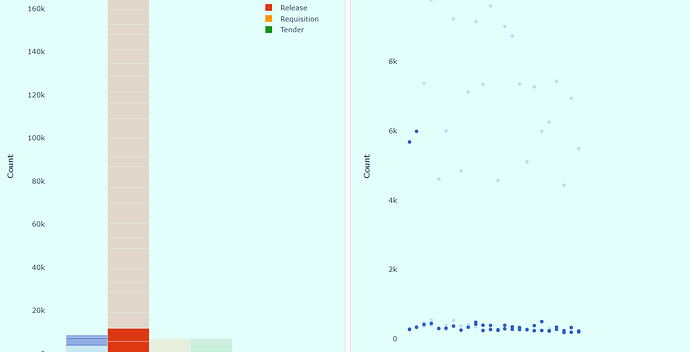Hi, All
I have been trying to add cross-filtering to dynamic graphs that share a base data frame. I got it to work but there is some underlining behaviour that happens. When I go to lasso and the callback applies the selected points it selects more than what was actually selected.
@app.callback([Output({'type': 'cross_filter_select', 'index': MATCH}, 'data')],
[Input({'type': 'graph-display', 'index': MATCH}, 'selectedData')],
[State({'type': 'tile-link', 'index': ALL}, 'className')],
prevent_initial_call=True)
def do_stuff(selected_data, link_state):
changed_id = [p['prop_id'] for p in dash.callback_context.triggered][0]
if changed_id == '.':
raise PreventUpdate
tile = int(search(r'\d+', changed_id).group())
point = None
trace = None
if selected_data is not None:
if link_state[tile] == 'fa fa-link' and len(selected_data['points']) != 0:
point = [p['pointNumber'] for p in selected_data['points']]
trace = [p['customdata'] for p in selected_data['points']]
selected = [{'point': point}, {'trace': trace}]
filter = selected
return [filter]
for x in range(4):
@app.callback([Output({'type': 'graph-display', 'index': x}, 'figure')],
[Input({'type': 'cross_filter_select', 'index': ALL}, 'data')],
[State({'type': 'graph-display', 'index': x}, 'figure')],
prevent_initial_call=True)
def cross_filter(selected_data, fig):
changed_id = [p['prop_id'] for p in dash.callback_context.triggered][0]
# callback context hasnt changed
if changed_id == '.':
raise PreventUpdate
tile = int(search(r'\d+', changed_id).group())
if selected_data[tile][0]['point'] is not None:
trace = []
# assigns the selected point to the corresponding curve number to build the selected point lists
for selected_points in selected_data[tile][1]['trace']:
for index in range(len(fig['data'])):
if selected_points in fig['data'][index]['customdata']:
trace.append(index)
break
select = []
print(trace)
# makes the traces opaque to be able to distinguish the points that are selected on te graph
for index in range(len(fig['data'])):
fig['data'][index]['selectedpoints'] = {}
select.append([])
for count, index in enumerate(trace):
select[index].append(selected_data[tile][0]['point'][count])
# if selected_data[tile][0]['point'] in index:
# applies the selected points to the correct trace
for count, index in enumerate(select):
if len(index) != 0:
fig['data'][count]['selectedpoints'] = index
print(select)
else:
for index in range(len(fig['data'])):
fig['data'][index]['selectedpoints'] = None
return [fig]
I use the customdata to check to see if the the data is the same in the other graph. It may have to do with the callbacks and the amount that I have.
Thanks
